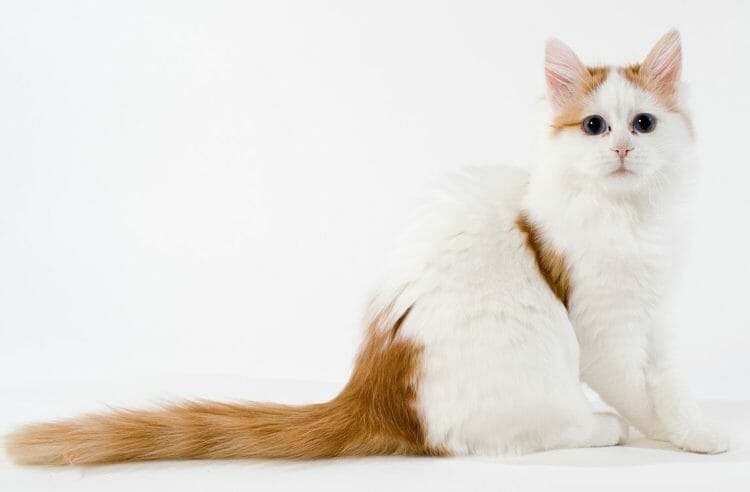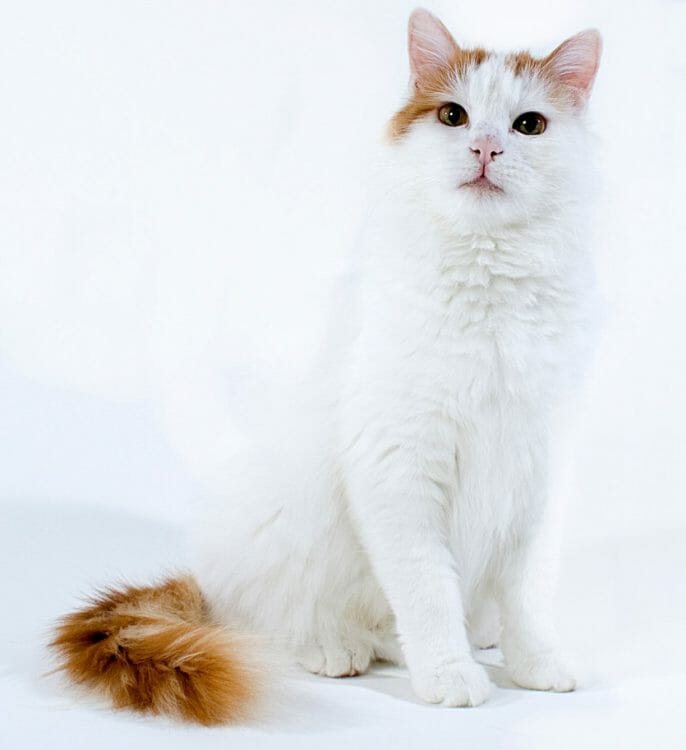Turkish Van Cat

Turkish Van Cat Personality
The Turkish Van cat is intelligent with plenty of energy, a playful personality, and a penchant for climbing. Perches allow the Turkish Van to survey its surroundings. They can move with considerable athleticism, which makes them impressive hunters. Using positive reinforcement, it is possible to train a Turkish Van to walk on a leash or perform tricks.
One of the things that makes this breed unique is their love of water, which earned them the nickname the “swimming cat.” Owners should not be surprised to see them splash in puddles, pools, or bathtubs. Their water-repellant coat hints that the breed may have hunted for fish in Lake Van where the breed originated.
Once a Van has been taken in by a family, it will make an affectionate pet and can usually be petted. Generally, this is not a breed that enjoys being picked up. Although a Turkish Van is usually happy to be near its owner, it does not enjoy sitting on laps. Instead, it prefers to sit beside people instead.
A Turkish Van can be kept on its own or with other cats of the same breed. In households where a dog is present, introductions should be made slowly. The breed can be kept around children. However, it is important to educate the child on how to approach and pet the cat respectfully.

What Does a Turkish Van Cat Look Like?
Although classified as a semi-longhaired cat, the length of the hair will change depending on the season. During the winter, the hair will be longer and thicker. The summer months see the cat shedding its hair to leave a lighter, shorter coat. The Turkish Van has only one coat and no undercoat.
Turkish Vans are rare and can be identified by the specific pattern of their coats. The cat is always white with color only being found on the head and tail. Eyes can be either amber or blue, but the breed is also known to have two different color eyes.
The breed often has a small mark between the shoulder blades. In Turkey, this is often called the “thumbprint of God,” and followers of both Judaism and Islam believe this mark to be where the breed was blessed by God.
An entirely white Turkish Van cat is known as a Turkish Vankedisi (or Van Kedi in their native Turkey). These types of cats are not regarded as being show quality and are often deaf. For this reason, most Turkish Vankedisi are rarely bred to one another.
The Turkish Van cat is large and well-built with broad shoulders. Its body and tail are long, with the tail being quite bushy. Typically, it can take between three and five years for Turkish Vans to reach full maturity.
Adult male Turkish Vans can weigh anywhere from 10 to 20 pounds, while females typically weigh between 7 and 12 pounds.

History of Turkish Van Cats
The Turkish Van cat is a domestic cat breed that traces its origins to the mountains of Turkey, in particular, the Lake Van region of the Armenian Highlands. Ancient folktales tell of the Turkish Van cat arriving at Mt. Ararat after leaving Noah’s Ark and swimming to land. Archeological artifacts that bear the likeness of the Turkish Van have been found in the Van area. These artifacts date back 5,000 years.
Over the millennia, the Van cat has adapted to its surroundings where the winters can be cold and the summers can be long and hot. It does this by changing its coat with the season.
Van cats found their way to Europe in the 11th and 12th centuries with the armies returning from the Crusades. Throughout the years, Van cats have been known under many names, including Russian Longhair Cat, Turkish Cat, Ringtail Cat, and Eastern Cat.
In the 1950s, two British photographers were given two Van cats. They brought these felines back to the United Kingdom. The pair mated, and the resulting purebred offspring was identical to the parents. The breed was soon officially recognized by British cat fancier organizations. More cats were then brought from Turkey so that further generations could be bred.
In 1969, the breed was given pedigree status as the Turkish Cat. However, the name was changed to Turkish Van in the United Kingdom in 1979. The United States also adopted the name in 1985.
The breed was imported to the United States throughout the 1970s. The International Cat Association gave the Turkish Van championship status in 1985. The Cat Fanciers Association (CFA) began accepting Vans for registration in 1988. In 1994, the CFA gave the breed championship status in 1994.

Grooming Turkish Van Cat
The semi-long-haired coat of the Turkish Van cat is water-resistant and not prone to matting. This is because there is no undercoat. Typically, dirt is naturally repelled making caring for the breed straightforward.
Brushing once a week is advisable to help remove any loose hairs. This will help to minimize hair that gets shed on carpets and furniture. Bathing is not necessary. However, these cats quite enjoy being in the water so the experience can be very positive.
To prevent gum disease, it is recommended that all felines have their teeth brushed at least a few times a week.

Turkish Van Cat Health Problems
Although any pedigreed or mixed breed cat may be prone to genetic health concerns, there are very few health problems to which the Turkish Van cat is predisposed. This is possible, in part, because the breed has existed for thousands of years in its native Turkey and is naturally occurring.
Some cats have been reported to suffer from a heart condition called hypertrophic cardiomyopathy (HCM), which can be genetic in breeds such as the Maine Coon. In Turkish Van cats, no genetic link has yet been proven. There is no cure for HCM and the prognosis for survival varies from months to years.
When welcoming a Turkish Van into any home, it is important to ensure that all vaccinations (such as those for rabies and distemper) are up to date and that an adequate pet insurance policy is taken out. This is so every eventuality can be prepared for without causing financial strain.

Turkish Van Cat Lifespan
The Turkish Van cat breed is generally very healthy and with few known health conditions. A Turkish Van cat can is expected to live a reasonably long life of between 15 to 17 years. Providing good quality food and plenty of exercise will help ensure that these felines do not become obese.
How Much Does a Turkish Van Cat Cost?
Although breeding Turkish Van cats is common, many often find their way to rescue shelters. Turkish Van cat adoption is always better than buying. Not only will adopting a cat or kitten be a more cost-effective route to ownership, but rescuing from a no-kill shelter will ensure a healthy animal does not get euthanized.




